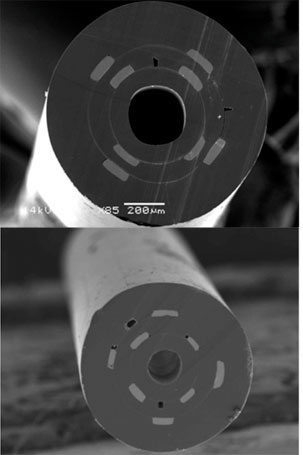| Posted: July 8, 2009 |
A fabric that acts as a camera |
|
(Nanowerk News) Imagine a soldier's uniform made of a special fabric that allows him to look in all directions and identify threats that are to his side or even behind him. In work that could turn such science fiction into reality, MIT researchers have developed light-detecting fibers that, when weaved into a web, act as a flexible camera. Fabric composed of these fibers could be joined to a computer that could provide information on a small display screen attached to a visor, providing the soldier greater awareness of his surroundings.
|
|
The researchers, led by Associate Professor Yoel Fink of the Department of Materials Science and Engineering (DMSE), emphasize that while such an application and others like it are still only dreams, work is rapidly progressing on developing fabrics capable of capturing images. In a recent issue of the journal Nano Letters, the team reported what it called a "significant" advance: using such a fiber web to take a rudimentary picture of a smiley face.
|
 |
| A micrograph showing the cross-section of a new optoelectronic fiber. (Image: Fink Lab, MIT)
|
|
"This is the first time that anybody has demonstrated that a single plane of fibers, or 'fabric,' can collect images just like a camera but without a lens," said Fink, corresponding author of the Nanoletters paper. "This work constitutes a new approach to vision and imaging."
|
|
Our eyes are a great example of Nature's approach to imaging: they involve a highly sophisticated and localized organ made in part of a delicate lens. Technologists have mimicked this approach in cameras, telescopes and even microscopes.
|
|
But lenses of natural or man-made origin have a limited field of view, and are susceptible to damage, leading to the loss of the imaging or seeing capacity altogether. Optical fiber webs, in contrast, provide a distributed imaging capability provided by the entire surface of a fabric, which is in principle much more robust to damage and "blindness." If one area is damaged, other fibers can still function, extracting the image.
|
|
"We are saying, 'instead of a tiny, sensitive object [for capturing images], let's construct a large, distributed system,'" said Fink, who is also affiliated with MIT's Research Laboratory of Electronics (RLE), the Center for Materials Science and Engineering (CMSE) and Institute for Soldier Nanotechnologies (ISN).
|
|
Nested Detection Layers
|
|
The new fibers, less than a millimeter in diameter, are composed of layers of light-detecting materials nested one within another.
|
|
Those layers include two rings of a semiconductor material that are light sensitive, each ring only 100 billionths of a meter across. Four metal electrodes contact each of the rings, extending along the length of the fiber, for a total of eight. Each semiconductor ring with its attached electrodes is in turn encased in rings of a polymer insulator that separate it from its neighbor.
|
|
|
|
The team starts with a macroscopic cylinder, or preform, of these elements. That preform is placed into a special furnace that melts the components, carefully drawing them into miniscule fibers that retain the original orientation of the various layers. The process can produce many meters of fiber.
|
|
Fink's team demonstrated the power of their approach by placing an object - a smiley face - between a light source and a small swatch of fabric composed of the fibers that was in turn connected to an external amplifying electrical circuit and computer.
|
|
The individual fibers measure the intensity of the light illuminating them and convert it to an electrical signal. Importantly, they are also designed to differentiate between light at different wavelengths or colors. A mesh of fibers is then deployed to measure light intensity distribution at different wavelengths across a large area.
|
|
In the current work, the smiley face was illuminated with light at two separate wavelengths. This generated a distinct pattern on the fabric mesh that was then fed into a computer. From there, an algorithm described earlier by the Fink team in Nature Materials assimilates the data to create a black-and-white image of the object on a computer screen.
|
|
"This paper furthers our vision of designing fiber materials and fabrics with ever-increasing sophistication and complexity," Fink said. He and colleagues note that additional optoelectronic layers in the fibers will lead to crisper images that could even be displayed in color.
|
|
"While the current version of these fabrics can only image nearby objects, it can still can see much farther than most shirts can," he said.
|

